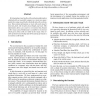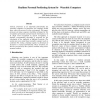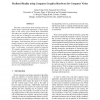PUC
2002
14 years 2 months ago
2002
: In this paper we describe continuing work being carried out as part of the Bristol Wearable Computing Initiative. We are interested in the use of context sensors to improve the u...
ASSISTIVE
1998
Springer
14 years 7 months ago
1998
Springer
Modern wearable computer designs package workstation level performance in systems small enough to be worn as clothing. These machines enable technology to be brought where it is n...
ISWC
1998
IEEE
14 years 7 months ago
1998
IEEE
The first wearable computer was conceived in 1955 by the author to predict roulette, culminating in a joint
ISWC
1999
IEEE
14 years 7 months ago
1999
IEEE
By integrating visual media with positioning information obtained with our wearable computer, we create new opportunities for using visuals both in the field and at the workstatio...
ISWC
1999
IEEE
14 years 7 months ago
1999
IEEE
Context awareness is an important functionality for wearable computers. In particular, the computer should know where the person is in the environment. This paper proposes an imag...
ISWC
2000
IEEE
14 years 7 months ago
2000
IEEE
With the continuous availability of wearable computers, users have the opportunity to create and acquire large numbers of files. The ability to store and retrieve documents effect...
ISWC
2002
IEEE
14 years 7 months ago
2002
IEEE
This paper explores the application of wearable computer systems to threat response, exemplified by the Multi-functional Micro-controllable Interface Module (MMIM)/Digital Militar...
ISWC
2002
IEEE
14 years 7 months ago
2002
IEEE
Human interaction with wearable computers is an important research issue, especially when combined with mixed reality (MR) applications. Natural and non-obtrusive means of interac...
ISWC
2002
IEEE
14 years 7 months ago
2002
IEEE
Does the use of a wearable context-aware computer increase task proficiency? User trials have been carried out in an attempt to answer this question. The study involves WECAPC sof...
ISWC
2002
IEEE
14 years 7 months ago
2002
IEEE
Wearable, camera based, head–tracking systems use spatial image registration algorithms to align images taken as the wearer gazes around their environment. This allows for compu...



